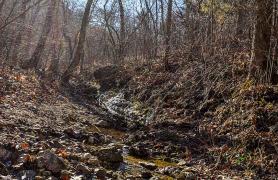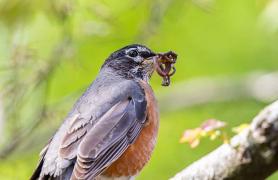
Years ago, my family was participating in an evening naturalist program on spiders. The naturalist was asking participants to identify photos of some common spiders. At the time, my 8-year-old son was truly thirsty for knowledge, and he was sitting on the edge of his seat waiting to be the first to identify one of the spiders. When the picture flashed on the screen, he leaped out of his chair and screamed, “Latrodectus mactans.” After a long awkward silence, the naturalist looked at him and said, “No, it is a black widow.” He came back to sit on my lap, devastated and looking for reassurance. As a supportive father, I reassured him he was right. As a biologist I had to whisper to my wife that he was partially right. The scientific name of the widow genus is Latrodectus, and in Missouri, we are blessed with two species, L. mactans and L. variolous. The picture was of Latrodectus variolous. I should have emphasized common names to him.
All in the Family
Black widows belong to the spider family Theridiidae, the comb-footed spiders or the cobweb spiders, and although they are probably the most famous spiders in this family, they are not the most abundant. The American house spider, Parasteatoda tepidariorum, is probably the most common comb-footed spider found in Missouri and maybe the most common spider in the world. This is probably because of their adaptability to human structures and are often found in houses, basements, barns, and other outbuildings. While most widow spiders are not deterred by human interaction and can be found in and around human structures, they aren’t as common as their cousins.
This family is called cobweb spiders by the general public because of their apparent messy webs with silk being placed in irregular patterns with no symmetry. They are identified as comb-footed spiders in the scientific world because of the presence of a row of serrated bristles that look like a comb on the last segment of their fourth pair of legs. Not easily seen with the naked eye, this “comb” is used to draw out and throw sticky silk from the spinnerets when wrapping prey captured in their web. Secure wrapping is critically important in this family because their chelicera and fangs that they use to inject their venom and digestive juices are small and lightly built.
American Species
North America has five species of widow spiders (all found in the United States) — one introduced species, the brown widow (L. geometricus), found along the gulf coast and southern California; one listed species, the red widow (L. bishop), endemic to Florida; and three common species of black widows, the northern (L. variolous), southern (L. mactans), and western (L. hesperus). The western black widow has a range from the Great Plains to the west coast. The northern and southern split the country geographically, as their names suggest, with significant overlap.
Show-Me Widows
Missouri has the northern and southern black widow. Both can be found throughout our state in all our terrestrial habitats — forests, glades, and prairies. Although generally well hidden, they can also be found in and around our houses in wood piles, rock piles, flower gardens, and old buildings. In the not so distant past when outhouses were still an important “room in the house,” the warm, moist, fly-rich environment was a gathering spot of many spiders, but especially preferred by black widows. This caused sometimes painful and not so positive interactions with humans.
Female black widows get all the attention. I believe it is not because of their toxic venom or their supposed predisposition to eating their mates, although that contributes to their name, local folklore, and the legends surrounding these spiders. I believe it is for their most obvious attribute — their striking color contrasts. Their shiny, almost porcelain-like, black color and the contrasting, almost acrylic-like red hourglass and spots on their fat abdomens are eye-catching. Add to that their large, rounded abdomen tapered toward the spinnerets in a teardrop shape and their much smaller cephalothorax (head and thorax region) and long delicate legs. They are beautiful spiders and somewhat hauntingly majestic when seen hanging upside down in their webs.
The Difference is in the Details
Separating the two can be easy when time is taken to observe them. The northern black widow (L. variolous) is generally smaller in size than the southern black widow (L. mactans), less than ½ inch (excluding legs). With the legs, it is up to 1 inch. The northern black widow’s hourglass is on the underside of her abdomen and is always distinct but broken. Meaning the thin middle portion of the hourglass is not there. There is also typically a row of red dots down the middle of her back. In immature spiders and adult males there may also be four white diagonal lines associated with the red dots. The males are half of the size of the females (1/4 inch excluding legs) and a much thinner body frame.
The southern black widow (L. mactans) is a little larger than ½ inch (excluding legs). With the legs, it is up to 1½ inches. The only red marks she has are the complete bright red hourglass mark on the underside of the abdomen, and a red spot just behind and above the spinnerets. Immature spiderlings approaching maturity may have a row of red dots down their back. If so, it might be difficult to distinguish from its northern cousin. Sometimes the hourglass color may range from yellowish to various shades of orange or red. Like its northern cousin, the males are about half the size of the females and the joints on their legs are orange-brown in the middle and black on the ends. On the sides of the male’s abdomen there are four pairs of red and white stripes.
Home Sweet Web
They live in unorganized webs in trees, shrubs, or on the forest floor; around rocks, clumps of grass, or small trees on glades and prairies; and basements, corners, or eves of structures. Their webs can be small or quite large depending on the space that is available and the abundance of food. The spiders can be found in a corner of the web many times hiding under leaves or debris. Prey is captured in the very strong and sticky silk. Once entangled, the spider rushes quickly to the prey, bites, and retreats a short distance. As the prey begins to succumb to the venom, the spider draws closer and wraps the prey tightly in a silk lunch bag. Once the prey is no longer struggling, they will begin to consume their lunch, injecting digestive juices into the prey and sucking their lunch through their hollow, strawlike fangs. Both males and females live in their webs until it is time for the males to find a mate. This journey begins after their final molt into adulthood.
Black widow silk is five times stronger than steel and, until recently, was always considered stronger than any other spider silk. Now, it is second to a spider found in Madagascar — the Darwin bark spider. Black widow silk has been used for several decades as crosshairs in gun sites, telescopes, periscopes, and microscopes survey levels because of its small size (1/10,000 of an inch), strength, durability, and its immunity to atmospheric pressure changes.
Life Cycle
Mating for both species takes place in spring or summer. After mating, the female can store a lifetime of sperm to fertilize all the eggs she will produce. She can lay up to nine egg sacs over her life span, each containing about 400 eggs. Eggs hatch in 20–30 days, and the spiderlings will molt once while in the egg sac and feed on their brothers and sisters until they are ready to emerge from the sac. Those surviving and emerging from the sac spend a few days in the web with mom then disperse through the process known as ballooning, shooting strands of silk out of their spinnerets until the wind catches them and carries them on air currents to their new homes where they build their own webs. It takes up to four months for females to mature and two to three for males depending on available food. The female may survive for up to two years and the male up to five to six months.
Although they live a short life that is mostly hidden from our view, and like most spiders, are often feared, misunderstood, and underappreciated, in the end, these beneficial and beautiful spiders add to our biological diversity and the overall health of our ecological system.
Black widow spiders have poor eyesight and are very dependent on their webs. When dislodged from their webs, they are not aggressive, and they usually roll up in a defensive ball or flee for the closest cover or dark space. Most bites occur when the contact is made with the web or when a dislodged spider is pressed against the victim’s skin and bitten defensively. The bite is painless or an inconspicuous pin prick. Their venom is a neurotoxin and can be very dangerous to individuals who are very young, old, or in poor health.
















Also In This Issue

Staff visit conservation areas and give their reviews.

Bird declines and why we must act now.
And More...
This Issue's Staff
Editor - Angie Daly Morfeld
Associate Editor - Larry Archer
Photography Editor - Cliff White
Staff Writer - Kristie Hilgedick
Staff Writer - Joe Jerek
Staff Writer – Dianne Van Dien
Designer - Shawn Carey
Designer - Marci Porter
Photographer - Noppadol Paothong
Photographer - David Stonner
Circulation - Laura Scheuler






















